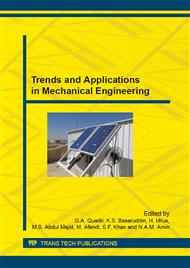[1]
M. Fizam Zainon, A. Khairel Rafezi, M. Ruhiyuddin Zaki, and Ruslizam Daud, Effect of Age Hardening on Wear Properties of Aluminum Alloys Piston, in Malaysian Metallurgical Conference, 2009, p.1–7.
Google Scholar
[2]
D. D. L. Chung, Composite Materials. Science and Applications, Second Ed. London: Springer-Verlag London, (2010).
Google Scholar
[3]
Azmah Hanim, S. C. Chung, and O. K. Chuan, Effect of a Two-Step Solution Heat Treatment on the Microstructure and Mechanical Properties of 332 Aluminium Silicon Cast Alloy, Mater. Des., vol. 32, no. 4, p.2334–2338, (2011).
DOI: 10.1016/j.matdes.2010.12.040
Google Scholar
[4]
A. Djebara, Y. Zedan, J. Kouam, and V. Songmene, The Effect of the Heat Treatment on the Dust Emission During Machining of an Al-7Si-Mg Cast Alloys, J. Mater. Eng. Perform., vol. 22, no. 12, p.3840–3853, (2013).
DOI: 10.1007/s11665-013-0675-z
Google Scholar
[5]
V. S. Zolotorevsky, N. A. Belov, and M. V Glazoff, Casting Aluminum Alloys, First Ed. Amsterdam: Elsevier Ltd., (2007).
DOI: 10.1016/b978-008045370-5.50007-9
Google Scholar
[6]
E. M. Elgallad, Effect of Additives on the Mechanical Properties and Machinability of A New Aluminum-Copper Base Alloy, University of Quebec at Chicoutimi, (2010).
DOI: 10.1522/030146241
Google Scholar
[7]
J. Qingxiu, Z. Caixia, and H. Xiaodong, Study on in-situ Mg2Si/ Al-Si Composites with Different Compositions, China Foundry, vol. 6, no. 2, p.133–136, (2009).
Google Scholar
[8]
C. Velmurugan, R. Subramanian, S. Thirugnanam, and B. Anandavel, Investigation of Friction and Wear Behavior of Hybrid Aluminium Composites, Ind. Lubr. Tribol., vol. 64, no. 3, p.152–163, (2012).
DOI: 10.1108/00368791211218687
Google Scholar
[9]
A. M. Garcia-Romero, P. Egizabal, and A. M. Irisarri, Fracture and Fatigue Behaviour of Aluminium Matrix Composite Automotive Pistons, Appl Compos Mater, vol. 17, p.15–30, (2010).
DOI: 10.1007/s10443-009-9117-3
Google Scholar
[10]
H. Kobatake, J. Schmitz, and J. Brillo, Density and Viscosity of Ternary Al–Cu–Si Liquid Alloys, J. Mater. Sci., vol. 49, no. 9, p.3541–3549, (2014).
DOI: 10.1007/s10853-014-8072-z
Google Scholar
[11]
M. Zeren, Effect of Copper and Silicon Content on Mechanical Properties in Al–Cu–Si–Mg Alloys, J. Mater. Process. Technol., vol. 169, no. 2, p.292–298, (2005).
DOI: 10.1016/j.jmatprotec.2005.03.009
Google Scholar
[12]
M. Zeren, The Effect of Heat Treatment on Aluminum Based-Piston Alloys, Mater. Des., (2007).
Google Scholar
[13]
M. Zhu, Z. Jian, G. Yang, and Y. Zhou, Effects of T6 Heat Treatment on the Microstructure, Tensile Properties, and Fracture Behavior of the Modified A356 alloys, Mater. Des., vol. 36, p.243–249, (2012).
DOI: 10.1016/j.matdes.2011.11.018
Google Scholar
[14]
M. Tiryakioglu, Si Particle Size and Aspect Ratio Distributions in an Al-7%Si-0. 6%Mg Alloy During Solution Treatment, Mater. Sci. Eng. A, vol. 473, (2008).
DOI: 10.1016/j.msea.2007.03.044
Google Scholar
[15]
J. Du, Y. Liu, S. Yu, and W. Li, Effect of Heat-Treatment on Friction and Wear Properties of Al2O3 and Carbon Short Fibres Reinforced AlSi12CuMgNi Hybrid Composites, Wear, vol. 262, no. 11–12, p.1289–1295, (2007).
DOI: 10.1016/j.wear.2006.11.020
Google Scholar
[16]
E. Georgatis, A. Lekatou, A. E. Karantzalis, H. Petropoulos, S. Katsamakis, and A. Poulia, Development of a Cast Al-Mg2Si-Si In Situ Composite: Microstructure, Heat Treatment, and Mechanical Properties, J. Mater. Eng. Perform., vol. 22, no. 3, p.729–741, (2012).
DOI: 10.1007/s11665-012-0337-6
Google Scholar
[17]
O. E. Sebaie, The Effect of Mischmetal, Cooling Rate and Heat Treatment on the Microstructure of 319, 356 and 413 Al-Si Alloys., McGill University, (2006).
Google Scholar
[18]
W. C. Chen, C. T. Wu, H. Y. Bor, and S. L. Lee, Effects of Cu Content on Thermal Stability and Wear Behavior of Al-12. 5Si-1. 0Mg Alloy, J. Mater. Eng. Perform., vol. 22, no. 12, p.3854–3859, (2013).
DOI: 10.1007/s11665-013-0634-8
Google Scholar
[19]
M. Emamy, A. R. Emami, R. Khorshidi, and M. R. Ghorbani, The Effect of Fe-Rich Intermetallics on the Microstructure, Hardness and Tensile Properties of Al–Mg2Si Die-Cast Composite, Mater. Des., vol. 46, p.881–888, (2013).
DOI: 10.1016/j.matdes.2012.11.041
Google Scholar
[20]
M. Yildırim and D. Ozyurek, The Effects of Mg Amount on the Microstructure and Mechanical Properties of Al–Si–Mg Alloys, Mater. Des., vol. 51, p.767–774, (2013).
DOI: 10.1016/j.matdes.2013.04.089
Google Scholar


